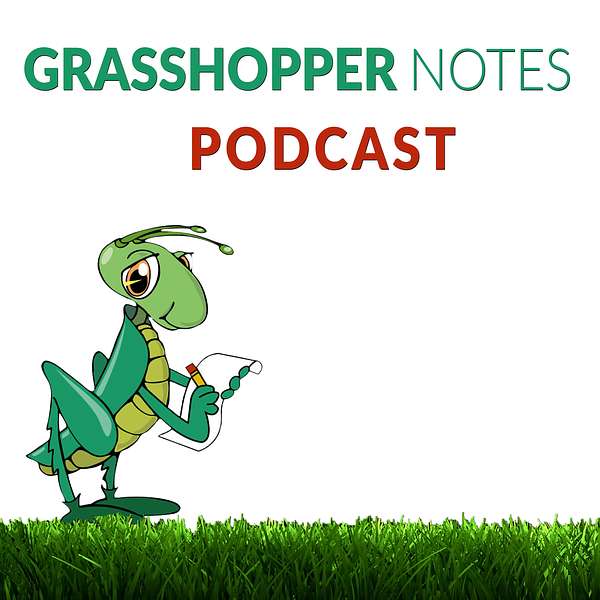
Grasshopper Notes Podcast
The Grasshopper Notes Podcast is hosted by John Morgan the man who has been billed as America’s Best Known Hypnotherapist.
John’s podcasts are a collection of guided meditations and bite-sized, mini podcasts which open you to new ways of thinking, communicating, and responding. You get a finer appreciation of how your mind works and how to use your internal resources to your best advantage.
See a video of John's background at the following link: https://www.youtube.com/watch?v=XbCPd00ok0I
In short, John Morgan is a people helper. Explore this channel and see what he can help you discover.
Grasshopper Notes Podcast
Are You Getting Through?
This week's Grasshopper Notes essay from John Morgan for the week of January 29th addresses the topic of how to get through more often.
Grasshopper Notes are the writings from America's Best Known Hypnotherapist John Morgan. His podcasts contain his most responded to essays and blog posts from the past two decades.
Find the written versions of these podcasts on John's podcasting site: https://www.buzzsprout.com/1628038
"The Grasshopper" is the part of you that whispers pearls of wisdom that seem to pop into your mind from out of the blue. John's essays and blog posts are his interpretations of these "Nips of Nectar." Others have labeled his writings as timeless wisdom.
Most of the John's writings revolve around self improvement and self help. They address topics like:
• Mindfulness
• Peace of mind
• Creativity
• How to stay in the present moment
• Spirituality
• Behavior improvement
And stories that transform you to a wider sense of awareness that presents more options. And isn't that what we all want, more options?
John uploads these podcasts on a regular basis. So check back often to hear these podcasts heard around the world. Who wants to be the next person to change?
Make sure to order a copy of John's new book: WISDOM OF THE GRASSHOPPER – 21 Days to Creativity. These mini-meditations take you inside where all your creative resources live. And you'll come out not only refreshed but recommitted to creating your future.
It's only $16.95 and available at BLURB.COM at the link below. https://www.blurb.com/b/10239673-wisd...
Also, download John's FREE book INTER RUPTION: The Magic Key To Lasting Change. It's available at John's website https://GrasshopperNotes.com
Are You Getting Through?
What’s the difference in feel when two words mean the same thing but come across differently?
For example, if someone writes they “beeped” the horn vs. “tooted” the horn, there’s a different feel communicated.
That’s why written communication is often misconstrued. Emails, texts, letters, blogposts, memos, etc. are open to multiple interpretations, depending on the meaning the reader has attached to certain words.
Of course, when we speak the words, a lot of the misinterpretation is removed due to our vocal emphasis or lilting of certain syllables or words. And when we add video or film to the spoken words, we get a more complete feel for the message.
What we’re doing in the last example is incorporating the three major communication systems we own: visual, auditory, and kinesthetic. The see, hear, and feel of it so to speak.
Think of your favorite teacher. Chances are their teaching style favored your preference for learning. Their communication style was either mostly auditory, or mostly visual, or mostly kinesthetic. They displayed the learning style you preferred most.
The really great teachers incorporate all three and reach more people. They have something for everybody.
Chances are when you’re not reaching someone with your message, you’re not presenting it in the style they prefer. If you start to notice that you’re not getting through, instead of saying the same thing over again, only louder, consider that you’re leaning on your preferred style of communicating vs. theirs and switch systems.
There are countless people out there that can teach this method much better than me. My message here is simply this: Pay attention to the people you’re addressing, instead of getting lost in your delivery, and notice if your message is landing. If not, go in a different direction. Come at it from a different angle.
The best example of your style not working is the story of the “ugly American” traveling in a foreign country expecting them to know what he’s saying in English. He approaches a street vendor who has a food booth and says, “I’ll have a hot dog.” The vendor looks at him quizzically and the mans says the same thing louder: “I’LL HAVE A HOT DOG.” The vendor responds with a palms up gesture, a lift of his shoulders and tilt of his head, and facial contortions that communicate, “I don’t understand.” And this guys says, “What are you, stupid, I just wanted a hot dog.” And walks off in a huff.
Get in the habit of noticing when you’re going into your talking trance, meaning you’re only giving attention to what you’re saying and not to the person you’re addressing. When you catch yourself doing this, and switch gears, your message will reach more eyes and ears. Ya feel me?
All the best,
John
